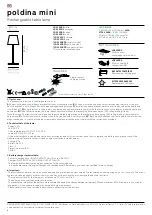
6
Setting Up
RoboColor III
C on n ec t th e l i g h ti n g c on t r o l l er
Once all heads have been connected to the RoboColor III controller, connect the
RoboColor III controller to the lighting controller. The procedure is the same for a
Martin RS-485 or DMX 512 controller, but you may need a 5-to-3-pin adapter
cable if using a DMX 512 controller.
1
Connect the data output on your lighting controller to the data input on the
RoboColor III controller.
MARTIN CONTROLLER: Use the XLR-XLR or DSUB-XLR cable supplied with
the controller.
DMX CONTROLLER: Most DMX controllers have 5-pin XLR sockets for data
output. Use a 5-pin to 3-pin phase-reversing adaptor, such as P/N 11820003,
as shown below. This adaptor connects pin 2 on one end to pin 3 on the other
end, and vice versa, to correct the difference in polarity between the
RoboColor III system and the DMX controller.
Note: The RoboColor III controller also has an option to swap the XLR pin
connections, making phase-reversing cables unnecessary. See page 18.
Martin Lighting Controller
with 3 pin XLR output.
3 pin XLR female:
Pin 1: GND (screen)
Pin 2: Signal (+)
Pin 3: Signal (-)
3 pin XLR male:
Pin 1: GND (screen)
Pin 2: Signal (+)
Pin 3: Signal (-)
RoboColor III Controller
with 3 pin XLR in and output.
5 pin XLR male:
Pin 1: GND (screen)
Pin 2: Signal (-)
Pin 3: Signal (+)
Pin 4: N/C
Pin 5: N/C
DMX Lighting Controller
with standard 5 pin XLR output.
3 pin XLR female:
Pin 1: GND (screen)
Pin 2: Signal (+)
Pin 3: Signal (-)
RoboColor III Controller
with 3 pin XLR in and output.







































